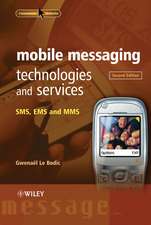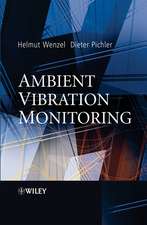Electromagnetic Vortices – Wave Phenomena and Engineering Applications: IEEE Press Series on Electromagnetic Wave Theory
Autor ZH Jiangen Limba Engleză Hardback – 3 ian 2022
Discover the most recent advances in electromagnetic vortices
In Electromagnetic Vortices: Wave Phenomena and Engineering Applications, a team of distinguished researchers delivers a cutting-edge treatment of electromagnetic vortex waves, including their theoretical foundation, related wave properties, and several potentially transformative applications.
The book is divided into three parts. The editors first include resources that describe the generation, sorting, and manipulation of vortex waves, as well as descriptions of interesting wave behavior in the infrared and optical regimes with custom-designed nanostructures. They then discuss the generation, multiplexing, and propagation of vortex waves at the microwave and millimeter-wave frequencies. Finally, the selected contributions discuss several representative practical applications of vortex waves from a system perspective.
With coverage that incorporates demonstration examples from a wide range of related sub-areas, this essential edited volume also offers:
- Thorough introductions to the generation of optical vortex beams and transformation optical vortex wave synthesizers
- Comprehensive explorations of millimeter-wave metasurfaces for high-capacity and broadband generation of vector vortex beams, as well as orbital angular momentum (OAM) detection and its observation in second harmonic generations
- Practical discussions of microwave SPP circuits and coding metasurfaces for vortex beam generation and OAM-based structured radio beams and their applications
- In-depth examinations and explorations of OAM multiplexing for wireless communications, wireless power transmission, as well as quantum communications and simulations
Perfect for students of wireless communications, antenna/RF design, optical communications, and nanophotonics, Electromagnetic Vortices: Wave Phenomena and Engineering Applications is also an indispensable resource for researchers in academia, at large defense contractors, and in government labs.
Din seria IEEE Press Series on Electromagnetic Wave Theory
- 24%
 Preț: 1053.41 lei
Preț: 1053.41 lei -
 Preț: 334.12 lei
Preț: 334.12 lei - 24%
 Preț: 729.27 lei
Preț: 729.27 lei - 9%
 Preț: 1132.76 lei
Preț: 1132.76 lei - 9%
 Preț: 1095.15 lei
Preț: 1095.15 lei - 9%
 Preț: 1385.06 lei
Preț: 1385.06 lei - 9%
 Preț: 919.33 lei
Preț: 919.33 lei - 9%
 Preț: 1066.44 lei
Preț: 1066.44 lei - 9%
 Preț: 1264.24 lei
Preț: 1264.24 lei - 9%
 Preț: 1170.46 lei
Preț: 1170.46 lei - 9%
 Preț: 1117.54 lei
Preț: 1117.54 lei - 9%
 Preț: 1468.12 lei
Preț: 1468.12 lei - 9%
 Preț: 956.53 lei
Preț: 956.53 lei - 9%
 Preț: 1065.90 lei
Preț: 1065.90 lei - 9%
 Preț: 1060.99 lei
Preț: 1060.99 lei - 9%
 Preț: 1218.29 lei
Preț: 1218.29 lei - 9%
 Preț: 826.38 lei
Preț: 826.38 lei - 9%
 Preț: 1080.08 lei
Preț: 1080.08 lei - 9%
 Preț: 991.59 lei
Preț: 991.59 lei - 9%
 Preț: 868.89 lei
Preț: 868.89 lei - 9%
 Preț: 792.82 lei
Preț: 792.82 lei - 9%
 Preț: 863.07 lei
Preț: 863.07 lei - 9%
 Preț: 937.01 lei
Preț: 937.01 lei - 9%
 Preț: 808.94 lei
Preț: 808.94 lei - 9%
 Preț: 868.89 lei
Preț: 868.89 lei - 9%
 Preț: 764.68 lei
Preț: 764.68 lei - 9%
 Preț: 827.12 lei
Preț: 827.12 lei - 9%
 Preț: 868.83 lei
Preț: 868.83 lei - 9%
 Preț: 938.91 lei
Preț: 938.91 lei - 9%
 Preț: 792.72 lei
Preț: 792.72 lei - 31%
 Preț: 885.66 lei
Preț: 885.66 lei - 31%
 Preț: 750.16 lei
Preț: 750.16 lei - 31%
 Preț: 1069.81 lei
Preț: 1069.81 lei - 30%
 Preț: 794.57 lei
Preț: 794.57 lei - 31%
 Preț: 732.13 lei
Preț: 732.13 lei - 32%
 Preț: 620.94 lei
Preț: 620.94 lei - 31%
 Preț: 1052.82 lei
Preț: 1052.82 lei - 29%
 Preț: 871.79 lei
Preț: 871.79 lei
Preț: 916.24 lei
Preț vechi: 1006.86 lei
-9% Nou
175.34€ • 190.40$ • 147.29£
Carte tipărită la comandă
Livrare economică 22 aprilie-06 mai
Specificații
ISBN-10: 1119662826
Pagini: 496
Dimensiuni: 178 x 254 x 28 mm
Greutate: 1.08 kg
Editura: Wiley
Seria IEEE Press Series on Electromagnetic Wave Theory
Locul publicării:Hoboken, United States


























